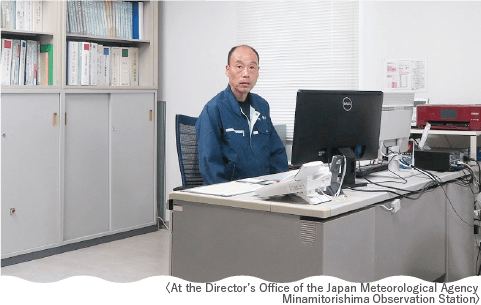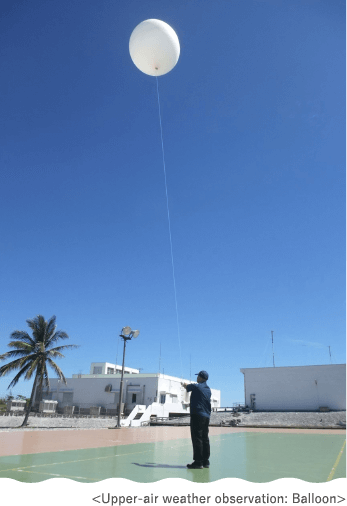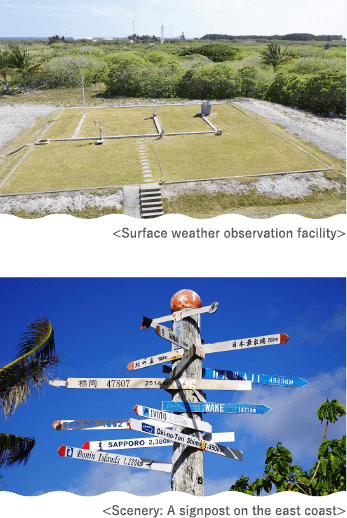
A.I entered the Japan Meteorological Agency (JMA) and worked at the Mount Fuji Weather Station (now the Special Automated Weather Station), the Sapporo and Tokyo Regional Headquarters, and other places. In addition, as a JMA member of the 36th and 49th Japanese Antarctic Research Expeditions, I worked at Syowa Station, where we conducted surface and upper-air weather observations.
A.Currently, I'm the Director of the Minamitorishima Observation Station of the Operation Division in JMA's Atmosphere and Ocean Department. I engage in meteorological observation, environmental observation, and maintenance and management of the facility. In addition, I coordinate with the Auxiliary Air Facility Minamitorishima (Japan Maritime Self-Defense Force [JMSDF]) and Minamitorishima Port Conservation and Management Office (Kanto Regional Development Bureau) stationed on the island to ensure smooth operations. It's also my job as the director to manage the employees' health.
A.Meteorological observations on the Minamitorishima Island were started in 1935 by the Meteorological Team of the Imperial Navy's Hydrographical Department. After the war, the island was occupied by the U.S. military, but after the return of the Ogasawara Islands to Japan in 1968, JMA set up the Minamitorishima Observation Station, and has since been conducting weather observations with the support of the Ministry of Defense (MOD).

A.Currently, staff from JMA, the JMSDF and the Kanto Regional Development Bureau are stationed on the Minamitorishima Island. From JMA, about ten employees are dispatched on a three-month rotation.

A.The Minamitorishima Observation Station conducts surface weather observations to measure things like temperature, wind direction and speed, and precipitation, and upper-air weather observations using balloons to measure things like temperatures and wind direction and speed about 30 km in the air. We also observe teletsunamis to detect tsunamis caused by earthquakes that occur far away from Japan in the Pacific Ocean (e.g., off the coast of Chile in South America) before they reach the coast of our mainland. These observation data are sent to JMA via satellites and used for disaster prevention information such as weather and tsunami alerts and warnings.
We also conduct various global environmental observations on the island, including ones on carbon dioxide and other greenhouse gases, particles suspended in the atmosphere (aerosols), and the strength of solar radiation. Our global environmental observations are highly praised worldwide. In 1993, the island was recognized as the most suitable place for observing the global environment by the Global Atmosphere Watch (GAW), a program established by the World Meteorological Organization (WMO) which is a specialized agency of the United Nations. It's one of only 30 Global stations in the world (as of October 2021). In addition, with the cooperation of MOD, JMA also observes greenhouse gases by taking air samples on the flight path to the island when its staff travels to the island (about 6 km high, in the middle of the troposphere).



A. Because the Minamitorishima Island is a remote island far from Tokyo, there are many difficulties in transporting goods and allocating our staff in order to carry out observations. However, because it's a remote island in the Pacific Ocean, it's far from major urban areas and not directly affected by human activity. We're taking advantage of that fact to carry out various global environmental observations. We believe that continuing to make accurate and persistent observations about the weather and global environment will contribute to disaster prevention and mitigation, and that this work is important for protecting the future global environment.